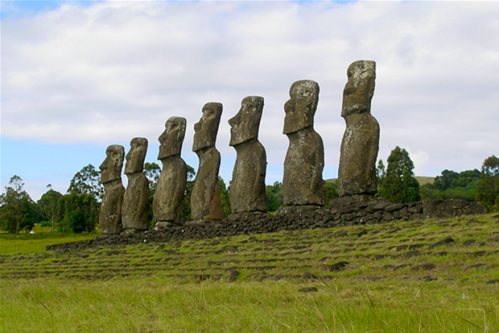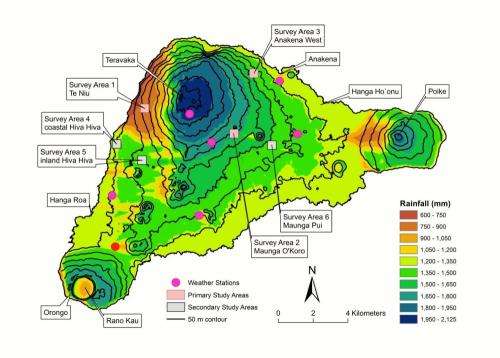Researcher uncovers surprising cause of the demise of Easter Island indigenous population

A new paper by a team of researchers including a Virginia Commonwealth University anthropology professor sheds new light on what led to the downfall of the indigenous population of Easter Island—also known as Rapa Nui—prior to European contact in 1722.
The study, "Variation in Rapa Nui (Easter Island) Land Use Indicates Production and Population Peaks Prior to European Contact," published in the Proceedings of the National Academy of Sciences, found that the population's demise likely had more to do with pre-existing environmental conditions than with environmental degradation by the indigenous people.
Christopher Stevenson, Ph.D., an assistant professor of anthropology in the School of World Studies in the College of Humanities and Sciences, recently discussed his team's findings with VCU News.
Your paper explores what led to the collapse of the prehistoric population of Rapa Nui. What did you conclude?
Our paper evaluates a longstanding debate and examines whether the prehistoric population of Rapa Nui experienced a significant islandwide demographic collapse prior to European contact in A.D. 1722. We have used dates from hydrated obsidian artifacts recovered from habitation sites as a proxy for land use over time. The analysis suggests region-specific dynamics that include abandonment of western coast and interior locations. These temporal land-use patterns correlate with rainfall variation and soil quality. The environmental stresses are regionally specific rather than islandwide. Significant erosion around the entire island generated by deforestation has been hypothesized by other researchers as a cause for economic failure. This does not hold up to scrutiny.
How would you characterize the significance of your findings?
This analysis demonstrates that the concept of a sudden "collapse" is a misleading characterization of prehistoric human population dynamics. As a result, we see our approach as useful in the study of other prehistoric societies for which a very rapid demographic collapse has been proposed in prehistory.
Although small, islands can be complex ecosystems that are structured by climatic variation and underlying geology. Human activities are constrained by these parameters and can even cause the ecosystem conditions to change appreciably through their manipulation of the landscape.

Were you surprised by what you found? In what ways?
The results of our research were really quite surprising to our team. Indeed, in the past we've published articles about how there was little evidence for pre-European contact societal collapse. When we proposed the [National Science Foundation-funded] project we were expecting that we would gather data supporting the notion that change did not occur until after European contact. In contrast our research suggests that significant changes in land use occurred prior to European contact. The connection between those changes in land use and notions of environmental degradation and subsequent societal collapse are limited.
There is no evidence that massive physical erosion took place on Rapa Nui before European contact and it is unlikely that physical erosion caused productivity decline and societal collapse. While we do not have direct population data, it is clear that people were reacting to regional environmental variation on the island before they were devastated by the introduction of European diseases and other historic processes. In short, our research does not support the suggestion that societal collapse occurred prior to European contact due to physical erosion and productivity decline, but it does indicate that use of less optimal environmental regions changed prior to European contact.
What did your research methodology entail?
We used a method called obsidian hydration dating to date the human creation of volcanic glass tools found at habitation sites. These dates were a proxy for the relative number of people on the island throughout prehistory. We also used an analysis of soil nutrients to look at the fertility of various landforms (e.g., coastal vs. upland) at different elevations up to 500 meters above sea level.
You've written several books on Rapa Nui. What led to your interest in this topic?
This is a continuation of my interest in looking at the development of agricultural systems in small island societies and how that impacts social and economic decisions made in prehistory.
What will you be working on next?
We will be applying some of the same concepts to the Canary Island agricultural systems which have a much higher diversity of geological ages and climatic conditions.
More information: phys.org/news/2015-01-history- … i-easter-island.html
Journal information: Proceedings of the National Academy of Sciences
Provided by Virginia Commonwealth University




















